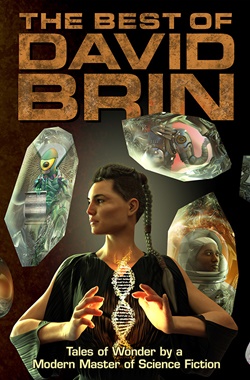
Speaking as both an astronomer and a science fiction author… and as one who has long participated in these fields, having served on some of the relevant committees… I am most definitely interested and will be tuning in! Still, I have to say that were this a matter for wagering, I would lean away from the trendy consensus.
For one thing, you can learn a lot just from the composition of Thursday’s panel:
Planned participants are:
– Mary Voytek, director, Astrobiology Program, NASA HQ
– Felisa Wolfe-Simon, NASA astrobio research fellow, U.S. Geol. Survey
– Pamela Conrad, astrobiologist, Goddard Space Flight Center
– Steven Benner, Foundation for Applied Molecular Evolution
– James Elser, professor, Arizona State University
Pause and consider. There are no exoplanetary astronomers. None. If there were new spectroscopic data about — say — exoplanetary atmosphere composition, wouldn’t there be an expert in that field?
Hence — and judging from the types of expertise represented — I would hazard to guess it may have to do with fresh discoveries in prebiotic and biotic chemistry. (One of the panel members has forecast imminent shortages of easily-mined free phosphorus on Earth. Will that be our next resource crisis? See it described in my next novel — EXISTENCE.)
Of course, I could be out there, chivvying and pillorying my own contacts in the field. I have plenty and would probably get the real deal, within hours. But why spoil the suspense? Anyway, I want to stay on the “First Contact rolladex.” That means not abusing privileges. So I’ll just tune in, like everybody else, and see!
Other Space News
One way to reduce launch costs: manufacture parts in space. A new company, Made in Space, proposes launching 3-D printers into orbit and using them to manufacture parts for spacecraft (satellites or the space station) – which would then be assembled in zero gravity. This would reduce the need to bring spare (plastic) parts. Broken pieces would be recycled as ‘feedstock’ for rapid prototyping. (I led the VERY FIRST pre-study of this general concept that was ever funded by NASA and the California Space Institute, back around 1984.)
Will we be able to grow crops on other planets to sustain human colonies? Scientists analyze soils on the Moon, Mars and Venus for potential agriculture. Aeroonics is another possibility for soil-less agriculture.
Project Icarus is a Tau Zero Foundation (TZF) initiative in collaboration with The British Interplanetary Society (BIS). Daedalus was a BIS project in the late 1970’s conducted over several years, to design an interstellar probe for a flyby mission to Barnards Star. Over three decades has now passed and it is an opportunity to revisit this unique design study.
Earlier this week my son and I stood in our backyard and observed the International Space Station crossing through the night sky — an inspiring sight. If you want to know when and where to look, check Heavens Above for your geographic position. It tabulates the location of the ISS, and satellites, as well as any visible comets.
And Science Fiction!
The 100 best movie spaceships.
How does Serenity compare to a TIE Interceptor, or Babylon 5 Station to a Klingon Transport vessel? Starship Dimensions, an online museum of vessels inspired by science fiction, puts it all to scale, contrasting dimensions of starships to real-life vessels.
And Miscellaneous Cool Stuff
The idea that we are entitled a life of happiness is a relatively new one. Past generations were more likely to accept their lot in life – with happiness a function of birth, bestowed by the fates or the gods, the reward for a virtuous life – or even delayed til a glorious afterlife. We who are less patient, believe it is our due, and yet, in the bustle of modern life, few seem to attain it…See A History of Happiness.
Seems time for some inspiring songs! Starting off, we went and saw Steve Martin and his bluegrass group perform this one in person, last month. Second time it was done on their tour. Heh.
Daniel Radcliffe sings one of my old favorites, Tom Lehrer’s The Elements live on television. Now THAT is the way Harry Potter oughta be! A nerd who uses his brains as much a he does his ubermesch-demigod innate magical power!
In fact, if you’d like to see that fantasy (a brainy-nerdy Harry Potter, who fights for the Enlightenment and for the rest of us (!) see “Harry Potter and the Methods of Rationality.” It’s an ongoing, web-published, not-for-profit (for obvious reasons) re-imagining of Dr. Rowling’s famed mythos… and it really is very, very very good.
Oh. Need anti-gravity or antimatter? How about immortality at $11 a gallon?
Fun abounds.
Only, next time… “Mr. Transparency” weighs in about Wikileaks!













